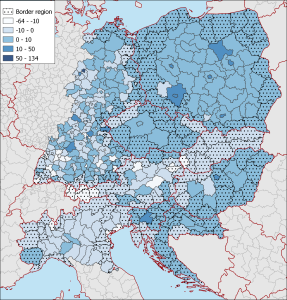Economic and demographic dynamics in Central-European
border regions between 2014-2020
Gábor Lados, Dávid Nagy, Réka Horeczki
 The 9th Cohesion Report has shown that cohesion policy has been able to further reduce disparities between regions, which is clearly visible when looking at the evolution of regional GDP over the last twenty years (EC, 2024), but also very visible when looking at the last seven years (Lados-Nagy-Horeczki, 2024). In this analysis our aim is to identify the positive and negative anomalies in the border regions in Central Europe and to show the spatial variation in economic and population change.
The 9th Cohesion Report has shown that cohesion policy has been able to further reduce disparities between regions, which is clearly visible when looking at the evolution of regional GDP over the last twenty years (EC, 2024), but also very visible when looking at the last seven years (Lados-Nagy-Horeczki, 2024). In this analysis our aim is to identify the positive and negative anomalies in the border regions in Central Europe and to show the spatial variation in economic and population change.
The Findings
In terms of economic and demographic conditions, an East-West divide can be identified in the Central European macro region; typically, the eastern regions are experiencing a permanent decline, and the population of the western regions is stagnating or growing at a minimal rate.
Highlighting the areas near the border and away from the border, the results show contrasting trends. For both categories, the results are presumably strongly influenced by administrative delimitation, with capital cities and other regional centres showing a higher concentration of the respective indicator. This is particularly true in border regions, where a few large cities have stronger influence on the results. Based on our current results and previous research, we assume that the social and economic cleavages that have emerged within Europe are creating a high level of polarization.
Why is it important to reduce inequalities?
Border regions account for almost one third of the population and less than 30% of the European Union’s GDP. They face a number of challenges in terms of infrastructure, job creation and demography, and thus a common problem for border regions is population retention. These challenges are more concentrated in Central European border regions, which are partly external borders of the European Union. Many funds, including Interreg Programme, are trying to bring these regions into the economic mainstream, but there are still many barriers and difficulties.
Why should we focus on this region?
The current rate of population decline raises many questions about the future of the Central European macro region. The economic risks arising from the depopulation of certain areas can also cause regional and national tribulations, over time, this situation could be followed by further social and economic backwardness, with the demographic spiral appearing unstoppable.
Economic and demographic dynamics in Central European border regions between 2014-2020 – Gábor Lados, Dávid Nagy, Réka Horeczki
DETUROPE – The Central European Journal of Regional Development and Tourism 2024, 16(3):99-120 | DOI: 10.32725/det.2024.013


